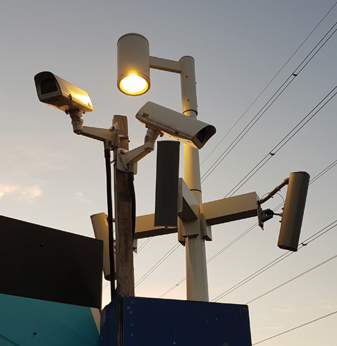Fraser Sampson is the government’s new independent Biometrics and Surveillance Camera Commissioner. That replaces two posts of the Biometrics Commissioner, and Surveillance Camera Commissioner. The statutory responsibilities and duties for both roles will remain the same, says the Home Office.
Fraser Sampson, who took up his post on March 1, will promote compliance with the Surveillance Camera Code and rules on police use of DNA and fingerprints.
Home Secretary Priti Patel said: “It is vital the government works to empower police to use technology to keep the public safe while maintaining their trust and Fraser Sampson’s extensive experience in law and policing makes him the right person to take up this role.”
And Fraser Sampson said: “I’m delighted to have been appointed to cover these two distinct but increasingly overlapping roles. I look forward to working with all partners in what is a fast-moving and challenging area of balancing the public interest considerations with the rights of individuals.”
About Fraser Sampson
He was an Honorary Professor and Research Fellow at Sheffield Hallam University. He is a Solicitor of the Senior Courts of England & Wales. Between 2016 and 2019, he was Chief Executive of the Police, Fire & Crime Commissioner in North Yorkshire. Between 2006 and 2019, he was the Chief Executive and General Counsel for the Police & Crime Commissioner in West Yorkshire and the Executive Director of the Civil Nuclear Police Authority. He was also a police officer for West Yorkshire Police and the British Transport Police, between 1982 and 1996.
The Biometrics Commissioner and Surveillance Camera Commissioner roles were set up by the Protection of Freedoms Act 2012.
Comments
Peter Webster, director of the CCTV User Group, welcomed the appointment. He said: “We welcome the appointment of the new commissioner to oversee and promote compliance with the CCTV Code of Practice. Fraser comes to the office with excellent credentials, and we look forward to working with him in his new role to promote high standards in the use of CCTV surveillance for public safety and security.”
And Ilker Dervish, vice chair of the CCTV User Group, said: “The members of the CCTV User Group welcome the appointment of Fraser Sampson as the new Biometrics and Surveillance Camera Commissioner as a clear confirmation that the Home Office continues to recognise the importance of public space CCTV systems in our communities. We are sure that Fraser Sampson’s experience and expertise will be a valuable contribution to the continuing development of regulations, guidelines and standards signposting a clear path to more effective and professional use of video surveillance systems.”
End of limbo
Mark Rowe writes: for the CCTV industry, this appointment ends the limbo that the Office of the Surveillance Camera Commissioner was in since last year when previous Commissioner – another ex-cop, Tony Porter – ended his term, having had it extended some months to see him able to comment officially on the landmark judgment by the Court of Appeal in the case of Bridges v South Wales Police in the force’s use of automatic facial recognition in public spaces such as at football stadia.
As that case suggests – and Porter having taken a job with a biometrics product company – biometrics and surveillance more generally have come together, so that the bringing together of the two regulators makes sense. Those regulators also had an overlap with the data protection regulator, the Information Commissioner’s Office (ICO) – the ICO and Tony Porter as the SCC had signed a memorandum of understanding; for video surveillance and biometrics data is personal data the same as customer names and addresses. However, the fact that the three were set up separately in the first place also implies that there’s a case for them to be considered separately.
While there was overlap – the SCC brought out ‘facing the camera‘ guidance as ‘good practice and guidance for the police use of overt surveillance camera systems incorporating facial recognition technology’ – the SCC also brought together several work streams of industry volunteers to take forward among other things the surveillance camera code of practice, and third party certification.
The new combined biometrics and surveillance camera commissioner will not only have a larger workload than the two predecessors; he will have work to do deciding how the two fields fit, and to keep the video surveillance sector on side he will have to keep up the work streams set up by Tony Porter.
As the past biometrics commissioner Prof Paul Wiles pointed out in a February 2020 lecture, to be precise he was ‘Commissioner for the Retention and Use of Biometric Material’. His remit only covered ‘police use of biometrics for criminal investigation and prosecution and for purposes of national security’, such as fingerprints and DNA.
Photo by Mark Rowe: CCTV cameras, Crossrail, Custom House station, east London.










